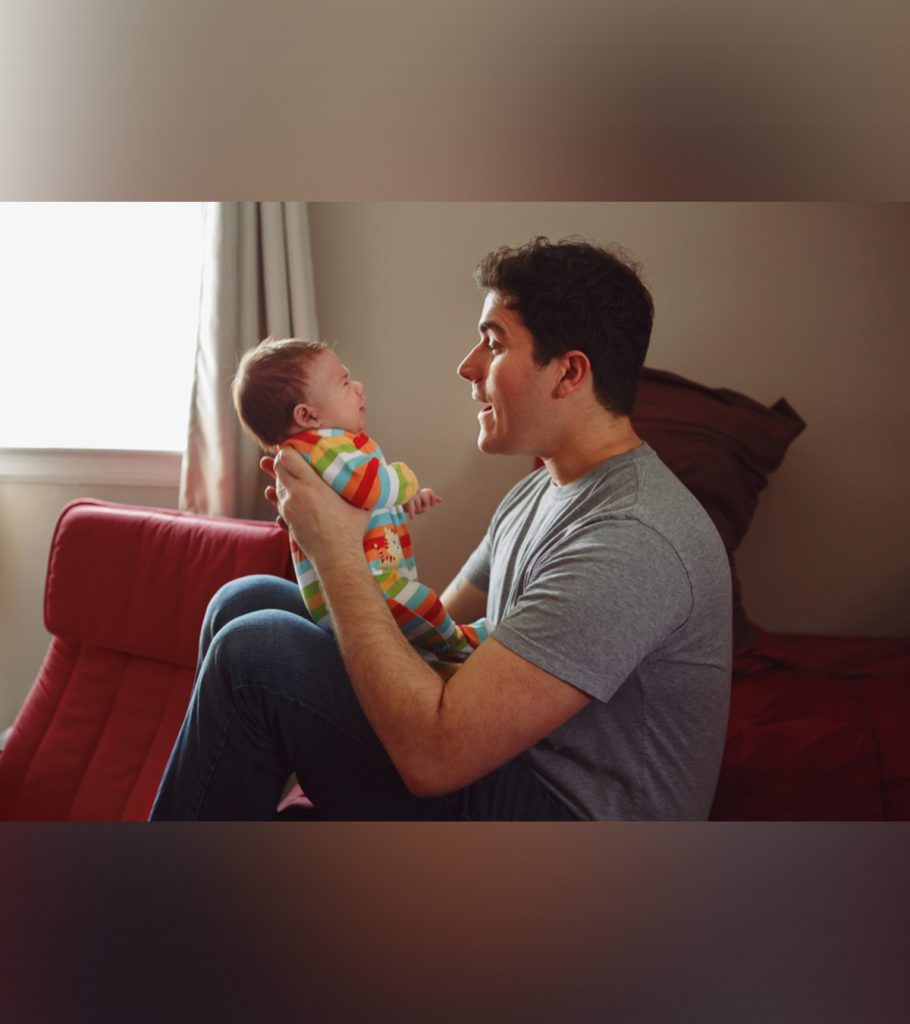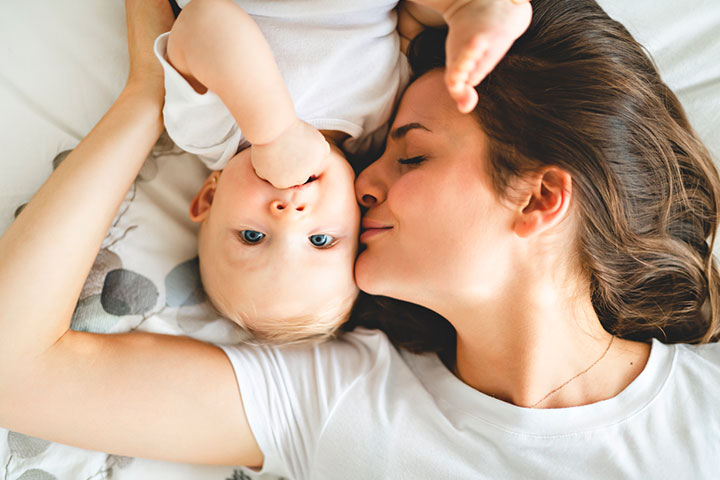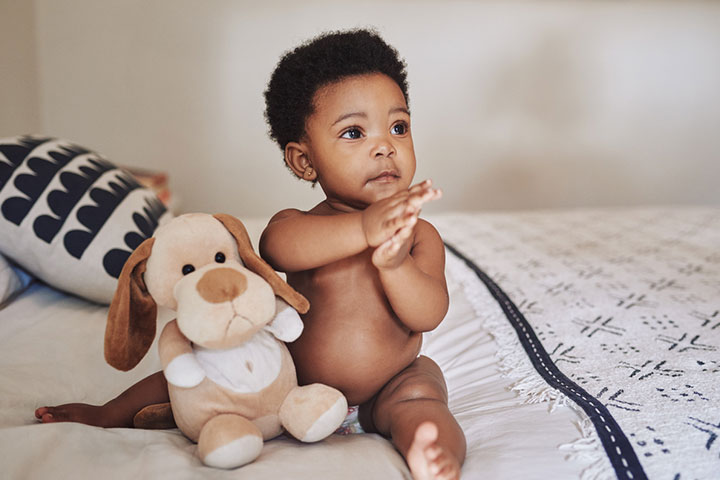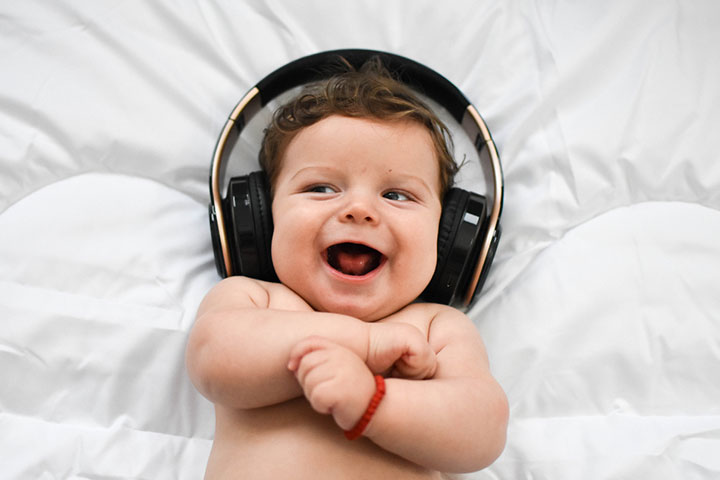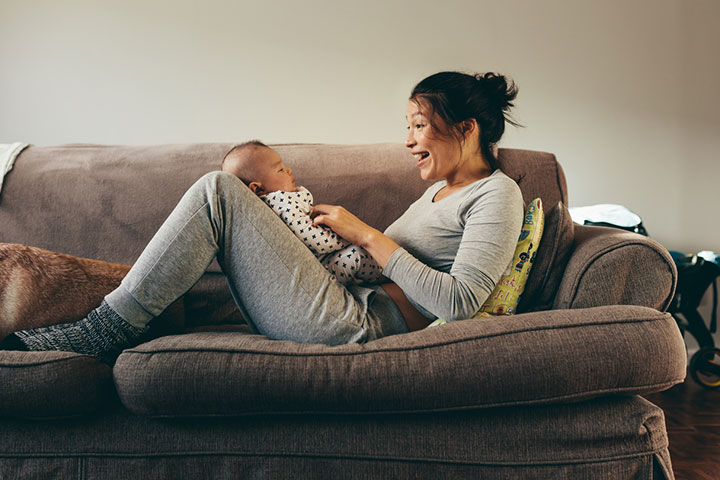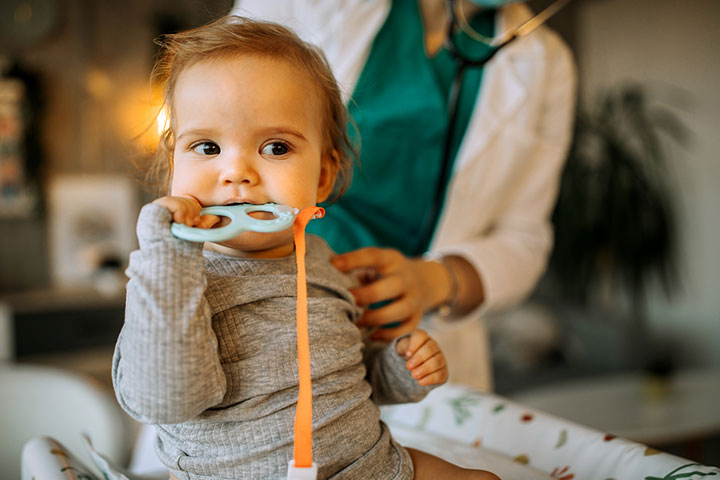The ‘da-da-da’ or ‘ba-ba-ba’ sounds your baby makes are the stepping stones to their first words. Baby babbling is a continuous string of vowel and consonant sounds produced by your little one. These repetitive mumbling sounds may seem meaningless, but it plays a major role in encouraging language development in infants. Besides babbling, your baby may make cooing, squealing, or gurgling sounds as well.
This post takes you through some reasons babies babble, the vocalization milestones associated with babbling, and tips on how parents can respond to it.
Why Do Babies Babble?
Newborns begin to babble to express their desire to talk, consequently constructing meaningful words and phrases at later stages of their language development. A baby would babble or start murmuring to mimic the words spoken by parents or caregivers or mimic the ambient sounds. You may notice your baby babbling in a tone that matches the pitches of your voice or accent. Babbling to imitate lays the foundation for learning new words through listening.
Babbling could also be a response to sensations. Babies’ senses are overwhelmed with several stimuli. Babbling is one of the many responses used to exhibit their reaction to their new sensations. Some babies may start crying, while some babble when startled by loud sounds. In such cases, when a baby might cry, they may babble at a higher pitch.
When Do Babies Start Babbling?
According to the American Academy of Pediatrics, babies begin to babble from the age of four months (1). The baby would babble with different tones to express emotions, and attempt to copy the sounds they hear (2). The babbling continues and improves as the baby grows older. It progresses to monosyllables by six months and bisyllables by nine months. By the age of 12 months, the baby will be able to speak simple words and exclamations, such as “Mama,” “Dada,” and “Oh” (3).
Despite the usual timelines, each baby may achieve babbling at a different age. The subsequent improvement in the skill may also vary among babies. Uday Dandavate, a grandparent, shares how he engaged in noticing the sequence of behavior of his granddaughter for three and a half months, which consists of sensing, observing, sense-making, and babbling. He says that her babbling reminds him of the sound of a musician tuning her instrument before playing it. He adds, “I suspect that while we want to believe that her babbling is a response to our baby talk, she is, in fact, enjoying manipulating our response by provoking us to ask questions through her babbling. Almost every time, she begins to babble before we start engaging her in a conversation (i).”
How Does Babbling Develop?
A baby begins with cooing and gurgling at the age of two months (4), followed by babbling from the age of four months. Infants usually evolve their burbling through the following two stages (5).
1. Canonical babble
- Between four and six months, infants begin to produce chains of syllabic sounds, combining consonants and vowel sounds. This is known as canonical babbling.
- It might include reduplicationiXA linguistic phenomenon in which a word or part of a word is repeated to create a new word or form. (dada, baba), long repetitions (mamama, dadadada), or interlacing syllables (ma, di, ba).
- Canonical babble might initially be gibberish but could seem similar to words or other sounds as the baby grows older (between eight and nine months). For instance, the baby’s babbling could begin to resemble their parents’ spoken words.
2. Jargon stage
- Between ten and 12 months, the baby will use babbling to express their feelings. A baby will babble to converse with those around them, shaping the babbling into a precursor to proper linguistic conversations. This is known as the jargon stage of babbling.
- The babbling of the syllables exhibits a resemblance to the baby’s native language. It could also have intonationsiXThe variations in pitch and tone that are used in speech.and pulsationsiXThe rhythmic beating or throbbing of the heart. similar to their parents’ speech, although you may not hear distinct words.
- This stage constantly evolves up to the age of 12 months, when babies usually utter their first word. Their first intelligible words may resemble their frequently babbled sounds.
What To Expect When Your Baby Starts To Babble?
Once a four-month-old begins to babble, they gradually achieve various babbling and other speech- and language-related milestones at different ages (6).
Four to six months
- Babbling may occur to imitate ambient sounds, noises, or the voices of the caregivers.
- The baby responds to sounds by making babbling sounds.
- The baby babbles a couple of vowel sounds, such as “ah,” “eh,” or “oh,” and simple consonant sounds, “buh” and “muh.”
- Some babies may respond to their names through babbling or giggling.
- They may also start cackling or make sucking noises with their tongue or purring sounds.
Six to twelve months
- An infant begins to repeat interlaced consonant and vowel sounds, such as“da-da-da”and “aa-ma-euh.”
- During this phase, a few babbled words may have meanings since the baby may repeatedly use them in specific situations or for certain objects. For instance, the baby may look at a toy and always babble “aabaa,” likely suggesting that the baby refers to that toy by the name.
- By the end of this stage, the baby may begin to say “Mama” and “Dada.” The baby may also try to babble the phrases or sentences you speak.
Twelve to twenty-four months
- The baby begins to speak simple single words, such as a cup, ball, car, and puppy, to name a few.
- The baby can speak sentences with two to four words, making them capable of communicating through simple phrases, such as “papa come” and “car go.”
- The baby says the name of the objects or person instead of babbling.
- By the end of this phase, the baby establishes a vocabulary of several words and can also repeat words with better diction.
How To Respond When Your Baby Babbles?
You may respond in any of the following ways to encourage babbling and stimulate your baby’s speech development (5).
Talk when they babble
- When the baby babbles, talk to them. You may speak to them about their surroundings, toys, or any other topic.
- Remember to pause so that they can listen to you and frame their response in the form of babbling.
- Keep the conversation going for as long as the baby wishes to babble. It could encourage the little one to initiate conversations in the future through babbling.
Observe the intent
- Observe the baby’s babbling to identify the intent of the sounds.Notice their gestures or expressions during babbling.
- When they babble and point to a toy, the babbling serves the purpose of expressing. Therefore, react affirmatively to convey that their babbling is understood.
- Babbling might be meaningless if you hear it while the infant is occupied with their toys or while in the play gym. In such cases, the baby might be imitating the background sounds.
Imitate your baby’s babble
- If your baby mostly babbles to imitate background sounds and not with the intent of communication, you may join the imitation game to encourage babbling.
- First, identify the sound your baby might be mimicking in their babble. It could be the sound of a car’s horn, the bark of a dog, or other ambient sounds.
- If you identify the sound, mimic the sound along with the baby. It could help suggest to the baby that you understand what they are thinking and you think the same. It could help reinforce babbling as a good way to communicate.
- Even if your baby babbles without any intent of mimicking, babble along with them. Copying the babbling sounds might seem silly, but it helps stimulate their conversational skills.
- You may imitate any aspect of their babble, such as tone, and do so while facing the baby.
Act as your baby’s interpreter
- Make your baby believe that you understand their babble. This earns you their attention and would push them to indulge in more conversation.
- For instance, when the baby points out a toy, label it with a name, and say things such as, “Yes, that is the fluffy toy there,” or “Wow! You just discovered the Teddy bear.”
- If the child is babbling syllables, such as ‘pa,’ while looking at the door, reciprocate by saying, “Yes, papa will come soon.”
- Make everything a learning experience. For instance, if the baby babbles and touches their nose, interpret it by saying, “This is your nose ”or “Who’s nose is it?”
- Interpretation of babbling could help build the baby’s vocabulary and improve their language skills as they grow older.
How To Encourage Your Babbling Baby To Speak Words?
Speaking words is the stage that comes after babbling. You could try the following ways to stimulate the healthy transition from babbling to speaking words (5).
- Begin by teaching simple words, such as “Yes” and “No.” You could frame questions to which the baby may respond in “Yes” or “No.” For instance, if the baby is cranky, ask them questions, such as, “Does the baby want to go to the park?” or “Is my little one hungry?”
- Label or give names to the objects in their surroundings. If you see them looking at a car, bus, or cat, introduce their names by saying them to your baby.
- If the baby babbles a sound or a syllable, associate it with an object’s name that begins with the sound. For instance, if the baby babbles “buh,” ask the baby if they are looking for a ball, bus, bed, or a book. It could help the baby learn that certain sounds could help them communicate about specific objects.
- Read to your baby from books with pictures where you can point at illustrations and name objects. It makes for an entertaining activity to improve the baby’s language skills.
- Once your baby is close to their first birthday, you could teach them simple greetings, such as “Hi,” “Bye,” and “Thanks.” You could also encourage them to repeat simple words.
What If Your Baby Is Not Babbling?
If your baby doesn’t babble at the age of four months, wait until they turn six months old. Most babies can babble from the age of six months. If your baby doesn’t babble by the age of seven months, see a pediatrician. This is particularly important if the baby does not make eye contact or cuddle up to parents.
Do not panic if the baby does not babble since there could be many reasons behind it. According to experts, speech delays are temporary and common; one in five children learns to speak later than their peers (7). Discuss the possible causes with a doctor. A pediatrician would speak to the parents about the baby’s achievement of other milestones and take the child’s medical history. A diagnosis for an underlying reason may be required, depending on the factors or conditions noticed in the baby. Some babies may be subjected to a hearing test, based on their assessment.
Baby babbling is the first step to talking, reciting, and singing. Babies usually babble as their language skills develop. Babbling should be encouraged as it teaches the child to form words, phrases, and sentences eventually. Babies may begin babbling from as early as four months of age. However, each baby may begin babbling at different times. Talking to them, reading books, singing songs, etc., can help them learn to talk sooner. If you have any apprehensions regarding speech delay in children, do not hesitate to talk to your pediatrician or speech therapist.
Baby babbling is the first step to talking, reciting, and singing. Babies usually babble as their language skills develop. Babbling should be encouraged as it teaches the child to form words, phrases, and sentences eventually. Babies may begin babbling from as early as four months of age. However, each baby may begin babbling at different times. Talking to them, reading them books, singing songs, etc., can help them learn to talk sooner. If you have any apprehensions regarding speech delay in children, do not hesitate to talk to your pediatrician or speech therapist.
Key Pointers
- Babies may start making cooing or gurgling sounds by the age of two months, followed by babbling by four months of age.
- Babies attempt to express emotions and copy sounds they hear through babbles.
- You can respond to your baby’s babble by talking to them, imitating them, or acting as an interpreter, making the baby believe you understand them.
